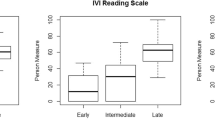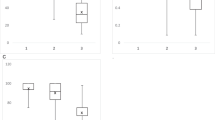Abstract
Purpose
To evaluate the association between ophthalmic structure/function measures and five standardized quality of life (QoL) instruments, in patients with advanced age-related macular degeneration (AMD).
Methods
We examined 20 AMD patients (ages 66–93 years) recruited from the Canberra Hospital Ophthalmology Department. Visual function measures included low and high contrast visual acuity (LCVA and HCVA) and measures from 10–2 Matrix visual fields (VF). Optical coherence tomography (OCT) quantified central retinal thickness (CRT), average macular thickness (AT), and retinal nerve fibre layer thickness (RNFL). The QoL instruments were the macular degeneration-related quality of life (MacDQoL), the National Eye Institute Visual Functioning Questionnaire (VFQ), its two face-recognition questions (A6 and 11), and the Geriatric Depression Scale (GDS). Pearson correlations, Canonical Correlation Analysis (CCA), and cross-validated stepwise-regression were used to examine the relationships between structure/function measures and the QoL instruments.
Results
The selected models for the five instruments had R2 ranging from 0.65 ± 0.12 to 0.90 ± 0.05 (mean ± SD) and median F-statistics > 188. HCVA was strongly associated with all QoL except the GDS, for which CRT, AT and RNFL figured highly. RNFL was most important for MacDQoL, and 2nd for VFQ question-A6. Centrally weighted VF measures were rarely selected but global VF measures were common, especially for the overall NEI-VFQ questionnaire. CCA revealed that the structure/function measures and QoL instruments contained 2 statistically independent mechanisms.
Conclusions
In patients with advanced AMD, CRT and HCVA were strong determinants of QoL instruments in AMD patients.



Similar content being viewed by others
References
World Health Organization (2015) Prevention of Blindness and visual impairment. https://apps.who.int/iris/bitstream/handle/10665/103646/9789241500173_eng. Accessed July 2019
Age-Related Eye Disease Study Research G (2001) A randomized, placebo-controlled, clinical trial of high-dose supplementation with vitamins C and E, beta carotene, and zinc for age-related macular degeneration and vision loss: AREDS report no. 8. Arch Ophthalmol 119(10):1417–1436
Macular Degeneration Foundation (2011) A Clear Outlook on Age-Related Macular Degeneration. http://www.mdfoundation.com.au/LatestNews/MDFoundationDeloitteAccessEconomicsReport2011. Accessed July 2019
Brown G, Brown M, Sharma S, Stein J, Roth Z, Campanella J, Beauchamp G (2005) The burden of age-related macular degeneration: a value-based medicine analysis. Trans Am Ophthalmol Soc 103:173–184
Mitchell J, Bradley C (2006) Quality of life in age-related macular degeneration: a review of the literature. Health Qual Life Outcomes 4:97
Ouyang Y, Heussen FM, Hariri A, Keane PA, Sadda SR (2013) Optical coherence tomography-based observation of the natural history of drusenoid lesion in eyes with dry age-related macular degeneration. Ophthalmology 120(12):2656–2665
Nassisi M, Lei J, Abdelfattah NS, Karamat A, Balasubramanian S, Fan W, Uji A, Marion KM, Baker K, Huang X, Morgenthien E, Sadda SR (2019) OCT risk factors for development of late age-related macular degeneration in the fellow eyes of patients enrolled in the HARBOR study. Ophthalmology 126:1667–1674
McClure ME, Hart PM, Jackson AJ, Stevenson MR, Chakravarthy U (2000) Macular degeneration: do conventional measurements of impaired visual function equate with visual disability? Br J Ophthalmol 84(3):244–250
Hazel CA, Petre KL, Armstrong RA, Benson MT, Frost NA (2000) Visual function and subjective quality of life compared in subjects with acquired macular disease. Invest Ophthalmol Vis Sci 41(6):1309–1315
Mitchell J, Bradley C (2004) Design of an individualised measure of the impact of macular disease on quality of life (the MacDQoL). Qual Life Res 13(6):1163–1175
Mangione CM, Lee PP, Gutierrez PR, Spritzer K, Berry S, Hays RD, National Eye Institute Visual Function Questionnaire Field Test I (2001) Development of the 25-item National Eye Institute Visual Function Questionnaire. Arch Ophthalmol 119(7):1050–1058
Sheikh JI, Yesavage JA (1986) Geriatric Depression Scale (GDS): Recent evidence and development of a shorter version. Clin Gerontol 5:165–173
Lane J, Mazlin JL, Irons J, Rohan E, Sabet F, Essex RW, Maddess T, Robbins RA, Gradden T, Dawel A, Smithson M, Barns N, He X, Crookes K, McKone E (2019) Caricaturing can improve facial expression recognition in low-resolution images and age related macular degeneration. J Vis 19(6):18
Lane J, Rohan EMF, Sabeti F, Essex R, Maddess T, Barnes N, He X, Robbins R, Gradden T, McKone E (2018) Improving face identity perception in age-related macular degeneration via caricaturing. Sci Reports 8:15205
Lane J, Rohan EMF, Sabeti F, Essex RW, Maddess T, Dawel A, Robbins RA, Barnes N, He X, McKone E (2018) Impacts of impaired face perception on social interactions and quality of life in age-related macular degeneration: A qualitative study and new community resources. PLoS ONE 13(12):e0209218
Age-Related Eye Disease Study Research G (2001) The Age-Related Eye Disease Study system for classifying age-related macular degeneration from stereoscopic color fundus photographs: the Age-Related Eye Disease Study Report Number 6. Am J Ophthalmol 132(5):668–681
Barbazetto I, Burdan A, Bressler NM, Bressler SB, Haynes L, Kapetanios AD, Lukas J, Olsen K, Potter M, Reaves A, Rosenfeld P, Schachat AP, Strong HA, Wenkstern A, Treatment of Age-Related Macular Degeneration with Photodynamic Therapy Study G, Verteporfin in Photodynamic Therapy Study G (2003) Photodynamic therapy of subfoveal choroidal neovascularization with verteporfin fluorescein angiographic guidelines for evaluation and treatment TAP and VIP report No 2. Arch Ophthalmol 121(9):1253–1268
Carkeet A (2001) Modeling logMAR visual acuity scores: effects of termination rules and alternative forced-choice options. Optom Vis Sci 78(7):529–538
Ferris FL 3rd, Freidlin V, Kassoff A, Green SB, Milton RC (1993) Relative letter and position difficulty on visual acuity charts from the Early Treatment Diabetic Retinopathy Study. Am J Ophthalmol 116(6):735–740
Anderson AJ, Johnson CA, Werner JS (2011) Measuring visual function in age-related macular degeneration with frequency-doubling (matrix) perimetry. Optom Vis Sci 88(7):806–815
Owen VM, Crabb DP, White ET, Viswanathan AC, Garway-Heath DF, Hitchings RA (2008) Glaucoma and fitness to drive: using binocular visual fields to predict a milestone to blindness. Invest Ophthalmol Vis Sci 49(6):2449–2455
Asper L, Crewther D, Crewther SG (2000) Strabismic amblyopia. Part 1. Psychophysics. Clin Exp Optom 83(2):49–58
Evans BJ (2007) Monovision: a review. Ophthalmic Physiol Opt 27(5):417–439
Yesavage JA, Brink TL, Rose TL, Lum O, Huang V, Adey M, Leirer VO (1982) Development and validation of a geriatric depression screening scale: a preliminary report. J Psychiatr Res 17(1):37–49
Efron B (1979) Bootstrap methods: Another look at the jackknife. Ann Statist Number 1:1–26
Brown MM, Brown GC, Stein JD, Roth Z, Campanella J, Beauchamp GR (2005) Age-related macular degeneration: economic burden and value-based medicine analysis. Can J Ophthalmol 40(3):277–287
Bennion AE, Shaw RL, Gibson JM (2012) What do we know about the experience of age related macular degeneration? A systematic review and meta-synthesis of qualitative research. Soc Sci Med 75(6):976–985
Taylor DJ, Hobby AE, Binns AM, Crabb DP (2016) How does age-related macular degeneration affect real-world visual ability and quality of life? A systematic review. BMJ Open 6 (12):e011504.
Bullimore MA, Bailey IL, Wacker RT (1991) Face recognition in age-related maculopathy. Invest Ophthalmol Vis Sci 32(7):2020–2029
Davis JM, McKone E, Dennett H, O'Connor KB, O'Kearney R, Palermo R (2011) Individual differences in the ability to recognise facial identity are associated with social anxiety. PLoS One 6 (12):e28800.
Curcio CA, Allen KA (1990) Topography of ganglion cells in human retina. J Comp Neurol 300(1):5–25
Gupta N, Ang LC, Noel de Tilly L, Bidaisee L, Yucel YH (2006) Human glaucoma and neural degeneration in intracranial optic nerve, lateral geniculate nucleus, and visual cortex. Br J Ophthalmol 90(6):674–678
Csaky K, Ferris F 3rd, Chew EY, Nair P, Cheetham JK, Duncan JL (2017) Report From the NEI/FDA Endpoints Workshop on Age-Related Macular Degeneration and Inherited Retinal Diseases. Invest Ophthalmol Vis Sci 58(9):3456–3463
Sabeti F, James AC, Carle CF, Essex RW, Bell A, Maddess T (2017) Comparing multifocal pupillographic objective perimetry (mfPOP) and multifocal visual evoked potentials (mfVEP) in retinal diseases. Sci Reports 7:45847
Sabeti F, Maddess T, Essex RW, James AC (2012) Multifocal pupillography identifies ranibizumab induced changes in retinal function for exudative age-related macular degeneration. Invest Ophthalmol Vis Sci 53:253–260
Han Y, Adams AJ, Bearse MA Jr, Schneck ME (2004) Multifocal electroretinogram and short-wavelength automated perimetry measures in diabetic eyes with little or no retinopathy. Arch Ophthalmol 122(12):1809–1815
Xu J, Lu P, Dai M, Huang W, Lin J, Huang J (2019) The Relationship Between Binocular Visual Field Loss and Various Stages of Monocular Visual Field Damage in Glaucoma Patients. J Glaucoma 28(1):42–50
Reilly MA, Villareal A, Maddess T, Sponsel WE (2015) Refined frequency doubling perimetry analysis reaffirms central nervous system control of chronic glaucomatous neurodegeneration. Trans Vis Sci Tech 4. https://doi.org/10.1167/tvst.1164.1163.1167
Funding
This research was supported by the Australian Research Council through the ARC Centre of Excellence in Cognition and its disorders (CE110001021, DP150100684), NHMRC Project grant (1028560) and Rebecca Cooper Medical Foundation Grant (PG2018040).
Author information
Authors and Affiliations
Corresponding author
Ethics declarations
Ethical approval and informed consent
The study was approved by the Human Research Ethics Committees of the Australian Capital Territory (ACT) Health (Protocol ETH.10.13.291), and the Australian National University (protocol 2013/286), and was conducted according to the Declaration of Helsinki. Written informed consent was obtained from all participants.
Conflict of interest
Authors FS declares that he has no conflict of interest. Author TM declares that he has no conflict of interest. Author JL declares that she has no conflict of interest. Author EMFR declares that she has no conflict of interest. Author EK declares that she has no conflict of interest. Author RWE declares that he has no conflict of interest.
Additional information
Publisher's note
Springer Nature remains neutral with regard to jurisdictional claims in published maps and institutional affiliations.
Rights and permissions
About this article
Cite this article
Sabeti, F., Lane, J., Rohan, E.M.F. et al. Relationships between retinal structure and function and vision-related quality of life measures in advanced age-related macular degeneration. Graefes Arch Clin Exp Ophthalmol 259, 3687–3696 (2021). https://doi.org/10.1007/s00417-021-05296-9
Received:
Revised:
Accepted:
Published:
Issue Date:
DOI: https://doi.org/10.1007/s00417-021-05296-9




